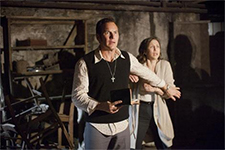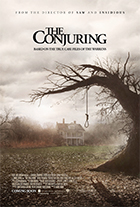The Conjuring
|  Although he began his career with the gruesome physical horrors of Saw (2004), Dead Silence (2007), and Death Sentence (2007), director James Wan has recently morphed into one of the most skillful purveyors of spiritual horror, trading in sharp weapons and dismembered limbs for creaking doors, strange noises, and ghostly shadows. His latest film, The Conjuring, builds on the effectiveness of his previous film, Insidious (2011), a well-orchestrated haunted house story full of foreboding atmosphere and visual freak-outs. Wan again demonstrates a dexterous understanding of how to build dread and goose the audience without actually showing much of anything, which is why it is somewhat disappointing that the film becomes a bit too literal in its final third, as if Wan felt that we might somehow feel cheated if we didn’t actually see a ghostly child or ghastly old woman. Although he began his career with the gruesome physical horrors of Saw (2004), Dead Silence (2007), and Death Sentence (2007), director James Wan has recently morphed into one of the most skillful purveyors of spiritual horror, trading in sharp weapons and dismembered limbs for creaking doors, strange noises, and ghostly shadows. His latest film, The Conjuring, builds on the effectiveness of his previous film, Insidious (2011), a well-orchestrated haunted house story full of foreboding atmosphere and visual freak-outs. Wan again demonstrates a dexterous understanding of how to build dread and goose the audience without actually showing much of anything, which is why it is somewhat disappointing that the film becomes a bit too literal in its final third, as if Wan felt that we might somehow feel cheated if we didn’t actually see a ghostly child or ghastly old woman.While much of The Conjuring will feel extremely familiar to anyone who has seen a haunted house movie, screenwriters Chad and Carey Hayes give us an interesting twist by making the protagonists not the victims of the haunting, but rather the paranormal experts who are called in to investigate. In this case, the investigators are Ed (Patrick Wilson) and Lorraine Warren (Vera Farmiga), real-life paranormal experts from whose case files the film’s story is supposedly taken. Ed (who passed away in 2006) was an expert in demonology (a title cards notes that he was the only non-ordained demonologist recognized by the Catholic Church), while Lorraine (who is still living and consulted on the film) claimed to be a clairvoyant—a “trance medium.” Wan presents them as an exceedingly normal, almost delightfully square, couple who just happen to have an extraordinary career. Wilson (who played the skeptical father in Insidious) and Farmiga have a pleasant, natural rapport as husband and wife—you can easily picture yourself sitting down and chatting with them over coffee—which helps ground the film emotionally. Ed’s concern over Lorraine’s spiritual vulnerability in dangerous paranormal situations feels like a genuine extension of a husband’s devotion to his wife, which gives the later horrors they face an added edge. The story in The Conjuring actually merges two otherwise unrelated cases the Warrens investigated in the early 1970s. The first, which forms a kind of prologue to the film, involves a possessed doll named Annabelle that becomes one of the many totems the Warrens keep in a special room in their house, locked away for safe keeping. The majority of the story, though, tells the story of a demonic possession of a Rhode Island farmhouse recently purchased by the Perron family. Father Roger (Ron Livingstone) is a truck driver, and mother Carolyn (Lili Taylor) is a stay-at-home mom who looks after their five daughters, who range in age from early teens to preschool (not surprisingly, The Brady Bunch makes a brief cameo at one point). The large, two-story farmhouse gives them plenty of room to run and play, but it has a run-down, ramshackle appearance that is subtly menacing (it’s always a bad sign when the dog won’t go past the front porch). More directly menacing is the boarded up staircase inside a closet that leads down to a particularly creepy, cobwebby basement filled with ominous antiques, and then the initial signs that there is a dangerous presence in the house (Lorraine later refers to it quite simply and effectively as “hateful”), which includes knocking sounds, slamming doors, rancid odors, and cold air. Soon, the presence is tugging at the sleeping girls’ feet, leaving mysterious bruises on Carolyn’s body, and otherwise asserting its anger that someone is living in the house. If much of this sounds like a variation on The Amityville Horror, that’s because the similarities are numerous (the Warrens, in fact, investigated the infamous Dutch Colonial and declared it to be the real deal). Hidden rooms, bad smells, menacing sounds, a child’s newfound invisible friend—we’ve seen all of this before, yet Wan makes it feel strikingly real and new. Part of the film’s effectiveness derives from Wan’s stylistic mastery of the genre material; he seems to know just how long to hold a shot, exactly where to place the camera, and how to frame the action for maximum tension and anticipation. He also has a feel for how pop music of the late 1960s and early ’70s can be profoundly unnerving when used in just the right way, especially if it’s emanating from the tinny speakers of a small radio (David Fincher did something very similar with Donovan’s “Hurly Gurly Man” in Zodiac). It doesn’t hurt, either, that Wan is working with a cast of veteran character actors who dig deep into their roles and give the film a profound sense of humanity. Interestingly, The Conjuring may be the most explicitly Christian movie to be released by a major studio in recent years. Haunting stories, especially those involving demonic forces, almost always find their source of goodness and resistance in a representative of the Catholic Church, a trope that The Conjuring abides by faithfully (it is, in this regard, a perfect example of what Robin Wood called “reactionary horror,” although I have always felt that such a term is, in itself, reactionary). However, while many horror movies dutifully trot out Catholicism without any real feeling, Wan’s film has an underlying subtext of reverence for the idea of a spiritual world outside our own, both good and bad. The horrors that are descended on the characters emanate from a force of true darkness that is genuinely terrifying, yet the film’s ultimate message is that darkness is not eternal. The fact that Ed and Lorraine Warren are presented as fundamentally decent, thoughtful, caring people suggests that part of their effectiveness as paranormal investigators comes from the sense of goodness they bring to places that are overrun with evil (Lorraine reminds him several times throughout the film that “God brought us together for a reason”). It is not surprising, then, that despite the fact that the film ends on a genre-required note of potential menace, it is prefaced by a quote attributed to Ed Warren that sets for the audience a genuine theological challenge: “The fairy tale is true. The devil does exist. God indeed exists. And for us, as people, our very destiny hinges upon which one we elect to follow.” Copyright ©2013 James Kendrick Thoughts? E-mail James Kendrick All images copyright © Warner Bros. |
Overall Rating: 


 (3.5)
(3.5)


